We've seen enough companies packing more performance into the best gaming laptops — while making them thinner and smaller — to call it a trend. Acer's Predator Helios Neo 14 ($1,599 as tested), with its Intel Core Ultra processor and Nvidia GeForce RTX 4070, offers solid gaming performance, though we’ve seen brighter screens. It also serves well for productivity thanks to good battery life and ample connectivity. If you value portability, this 14.5-inch Predator is a solid, if not remarkable, machine.
Design of the Acer Predator Helios Neo 14
The Predator Helios Neo 14 retains Acer’s signature black metal design seen in larger Predator models but is more compact, measuring 12.76 x 10.05 x 0.77 inches. With a 14.5-inch screen, it’s slightly larger than the Asus TUF Gaming A14 (12.24 x 8.94 x 0.78 inches) and the HP Omen Transcend 14 (12.32 x 9.19 x 0.71 inches). The Predator is the heaviest at 4.22 pounds, while the HP weighs 3.6 pounds and the Asus is the lightest at 3.22 pounds.
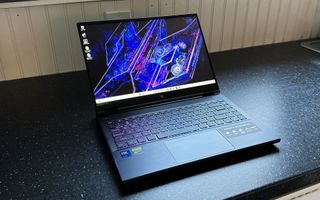
Like many newer gaming laptops, this Predator has a more subtle appearance than older models. The only part seeking attention is the illuminated Predator logo on the lid.

The logo’s color and lighting pattern can be changed or disabled entirely using the included Predator Sense app. Any color can be selected in static or breathing modes while neon mode cycles through all colors. I liked the lighting and left it enabled.
Although the chassis is sturdy and resists flexing or bending, I thought the metal used on most surfaces felt thin and not as premium as it should. The Razer Blade 14 (2024) has superior quality, albeit for a significantly higher price.
The ports on the left edge include the barrel-style AC power jack, a USB Type-A port, a Thunderbolt 4 USB Type-C port, and a 3.5 mm audio jack.

Acer Predator Helios Neo 14 Specifications
Swipe to scroll horizontally
| CPU | Intel Core Ultra 7 155H (6 Performance cores, 8 Efficient cores, and 2 Low Power Efficient cores; 4.8 GHz P-core Turbo Boost; 45W base power) |
| Graphics | Nvidia GeForce RTX 4070 Laptop GPU (8GB GDDR6, 1,605 MHz boost clock, 125W maximum graphics power) |
| Memory | 16GB LPDDR5X-6400 |
| Storage | 1TB SSD |
| Display | 14.5-inch, 2560 x 1600, 16:10, IPS, 120 Hz, G-Sync, Advanced Optimus |
| Networking | Killer Wi-Fi 6E AX1675i, Bluetooth 5.3 |
| Ports | 2x USB Type-A (5 Gbps), Thunderbolt 4 USB Type-C, USB Type-C (5 Gbps) 3.5 mm headphone/microphone jack, HDMI 2.1, MicroSD card reader |
| Camera | 1080p |
| Battery | 76 WHr |
| Power Adapter | 230W (barrel connector) |
| Operating System | Windows 11 Home |
| Dimensions (WxDxH) | 12.76 x 10.05 x 0.77 inches (324 x 255 x 20 mm) |
| Weight | 4.19 pounds (1.9 kg) |
| Price (as configured) | $1,799 ($1,599 when tested) |
Gaming and Graphics on the Acer Predator Helios Neo 14
We tested the Predator Helios Neo 14 with an Intel Core Ultra 7 155H processor, an Nvidia GeForce RTX 4070 Laptop GPU, and 16GB of RAM. The RTX 4070 has a 125W maximum graphics power rating.
I found Rise of the Tomb Raider to be extremely playable at 2560 x 1600 with Very High details. Outdoor scenes rendered around 100 fps and indoor scenes around 80 fps, with occasional dips to 60 frames per second in complex environments. At no point did the game stutter.
We compared the Predator to several 14-inch gaming laptops in benchmarks, including the Asus TUF Gaming A14 (AMD Ryzen 7 8845HS, RTX 4060 100W, $1,399 as tested), the HP Omen Transcend 14 (Core Ultra 7 155H, RTX 4060 65W, $1,809.99 as tested), and the Razer Blade 14 (2024) (Ryzen 9 8945HS, RTX 4070 140W, $2,699.99 as tested). While the Predator’s GPU has more wattage on tap than the Asus and especially the HP, the Razer, which is the most expensive, uses the most power.
We run the games at a 1080p resolution for straight comparisons and also at the laptop’s native resolution. The Asus and Razer are 2560 x 1600 like the Predator, but the HP is slightly higher, at 2880 x 1800.

In Shadow of the Tomb Raider (Highest in-game detail preset), the Predator achieved 96 fps at 1080p and 57 fps at native, slightly surpassing the Asus’s 90 fps and 52 fps, and significantly outperforming the HP, with 73 fps and 36 fps. The Razer was the fastest, with 121 fps at 1080p and 70 fps at native resolution.
In Cyberpunk 2077 (Ray Tracing Ultra), the Predator closely matched the Asus, producing 31 fps at 1080p and 16 fps at native compared to the Asus’s 30 fps and 15 fps. The HP was the slowest, with 21 fps at 1080p and 8 fps at native resolution, while the Razer was the fastest, with 42 fps and 23 fps.
Far Cry 6 (Ultra) was another close race, with the Predator producing 76 fps at 1080p and 58 fps at native resolution compared to the Asus’s 77 fps and 59 fps. The HP was behind them both while the Razer continued to be the fastest.
Red Dead Redemption 2 (Medium) was close at 1080p, with the Predator achieving 59 fps and the Asus 61 fps, but the Predator pulled significantly head at native resolution, with 37 fps compared to the Asus’s 30 fps.
In Borderlands 3 (using the game’s “Badass” detail preset), the Predator achieved 83 fps at 1080p and 55 fps at native resolution, significantly higher than the HP’s 63 fps and 34 fps. As in the other games, it couldn’t keep up with the Razer, which delivered 108 fps and 69 fps, respectively. (We don’t have data for the Asus in this test.)
GPU wattage is a key indicator of performance. The Predator’s robust 125W surpasses what we expect in a laptop this size and allows it to compete with larger gaming laptops. The HP’s 65-watt GPU was significantly slower and struggled to produce playable fps at its higher native resolution.
For stress testing, we simulate half an hour of gaming running the Metro Exodus benchmark 15 times at RTX settings. We measured an average of 68.5 fps across all runs with only a few tenths of a frame difference between runs, suggesting stable thermal performance. The P-cores of the Core Ultra 7 155H averaged 3.2 GHz and 74 degrees C, the E-cores averaged 2.7 GHz and 73 C, and the LPE-cores averaged 1.0 GHz and 74 degrees C. Meanwhile, the GeForce RTX 4070 Laptop GPU averaged 1.78 GHz and 71 degrees C.
Productivity Performance on the Acer Predator Helios Neo 14
Our Predator Helios Neo 14 has a Core Ultra 7 155H processor, 16GB of RAM, and a 1TB SSD.

In Geekbench, the Predator’s single-core score of 2,425 points outperformed the HP’s 2,362 points but fell short of the Asus’s 2,542 points and the leading Razer’s 2,684 points. In the multi-core scores, it achieved 13,019 points, surpassing the Asus’s 12,055 points but not quite reaching the HP’s 13,248 points or the Razer’s 13,781 points.
In our file transfer test, which involves moving 25 GB of data on the boot drive, the Predator achieved 1,785 MBps, outperforming the Asus’s 1,339.7 MBps and squeezing past the HP’s 1,729.5 MBps. However, the Razer proved the fastest, with 1,951.6 MBps.
The Predator completed our Handbrake test, which involves transcoding a 4K video to 1080p, in the quickest time of three minutes and 56 seconds. The Razer followed closely at four minutes and one second, while the Asus and especially the HP trailed.
Display on the Acer Predator Helios Neo 14
We reviewed the Predator Helios Neo 14 with a 2560 x 1600 IPS panel. At 14.5 inches, the screen is slightly larger than the typical 14-inch size. Gaming features include an anti-glare surface, a 120 Hz refresh rate, and Nvidia G-Sync for smoother framerates.
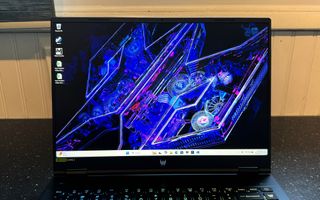

The Predator had the dimmest screen of the group, peaking at 358.2 nits, compared to the HP’s 392 nits and the Asus’s 411.4 nits. The Razer was significantly brighter at 446.6 nits. However, the Predator matched the Razer in color reproduction, covering 78.5% of the DCI-P3 gamut, and was just below the Asus’s 81.4%. The HP’s OLED screen was the most vibrant, covering 135% of DCI-P3.
Keyboard and Touchpad on the Acer Predator Helios Neo 14
Unfortunately, I found this Predator’s keyboard to be its weakest aspect. The keys are too easy to press and lack tactile feedback, which doesn’t inspire confidence. This was reflected in my MonkeyType online typing test score of 109 words per minute, which is about 10 to 15 wpm slower than my usual speed.
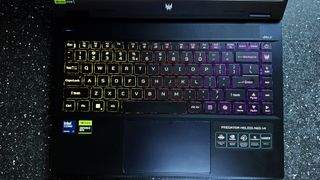
The literal bright side is that this keyboard offers three-zone RGB backlighting, which is better than the white backlighting offered in the Asus TUF Gaming A14. The HP Omen Transcend offers an additional zone while the Razer Blade 14 offers per-key backlighting.
The backlighting is configurable in the Predator Sense app. The zones can be set to specific colors in static mode. Dynamic effects include breathing, neon (color cycling), wave, shifting, zoom, meteor, and twinkling (flashing on and off). There are eight speed and four brightness adjustments. I found some animations, particularly wave, too quick even at the slowest setting. Additionally, I also noticed the keyboard backlighting turns off after 30 seconds, which is a setting in Predator Sense (It can be set to be always on.) Quibbles aside, the backlighting has ample brightness and looks laser sharp.
The touchpad is a strong point for the Predator, featuring a smooth matte surface and quiet, satisfying clicks. It can be disabled with the Fn + F10 keyboard shortcut.
Audio on the Acer Predator Helios Neo 14
The Predator’s down-firing speakers were disappointing when I listened to Eddie Money’s “Take Me Home Tonight.” Despite the DTS:X Ultra app’s software tuning, the speakers sounded strained, and the bass was almost nonexistent. The app’s presets for voice, movies, and gaming drastically altered the sound in unnatural ways (for example, the movie preset sounded very recessed), so I stuck with the music preset. Although there is an auto mode, it didn’t always correctly match the type of media I was listening to. There’s clearly room for improvement here.
Upgradeability of the Acer Predator Helios Neo 14
Upgrading the Predator Helios Neo 14 is challenging. Removing the nine Torx T6 screws securing the bottom panel is straightforward, especially since they’re the same length, but popping the clips securing it requires effort due to the almost seamless gap between it and the chassis. The panel hinges around the rear cooling vents, so it must be removed starting with the front edge. I used an ultra-thin plastic pry tool to make entry in one of the palm rest corners and then worked my way along the front edge.

The M.2 2280 PCI Express 4.0 SSD, M.2 2230 wireless card, and battery pack are all upgradeable. However, the LPDDR5X RAM is soldered down.
Battery Life on the Acer Predator Helios Neo 14
Gaming notebooks aren't known for their longevity, but the Helios Neo did OK in our tests. Our battery test involves web browsing, streaming video over Wi-Fi, and running OpenGL tests, all with the screen brightness set to 150 nits. Although the Predator lasted eight hours and 43 minutes, which wasn’t the longest (the Asus lasted 10 hours and four minutes), it still outperformed the Razer (six hours and 26 minutes) and the HP (five hours and 10 minutes).
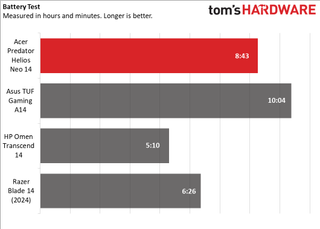
Heat on the Acer Predator Helios Neo 14
We stress test gaming laptops by running the Metro Exodus benchmark at RTX settings 15 times to simulate half an hour of gaming. We recorded temperatures of 118 degrees Fahrenheit between the G and H keys on the keyboard, 89 degrees on the touchpad, and a maximum of 117 degrees on the underside. While most of the laptop was ultimately cool enough to the touch, it does tend to run warm. The twin cooling fans are audible but subdued; I had no trouble hearing in-game sounds from the laptop’s speakers over them.
Webcam on the Acer Predator Helios Neo 14
The Predator’s 1080p webcam, centered over the display, delivers average video quality. My face and surroundings appeared somewhat blurry and exhibited noticeable graininess in low-light conditions.
The webcam lacks a sliding privacy shutter and an infrared sensor for Windows Hello logins. Additionally, there’s no fingerprint reader, so you’ll be stuck typing passwords.
Software and Warranty on the Acer Predator Helios Neo 14
Acer Predator Sense is the most important included app, offering system settings, monitoring tools, and lighting control. It features a battery charge limiter to extend battery life, a MUX switch to ensure the Nvidia GPU is always in use, and settings for a blue light filter and panel overdrive. It also has a component health checkup feature for the RAM, SSD, and battery, and displays GPU and CPU frequencies, temperatures, and network usage. The fans can be set to automatic or maximum, with user-defined curves available. These settings as well as RGB lighting controls can be linked to profiles and automatically launched with apps via Predator Sense app center.
The other important app is DTS:X Ultra that I mentioned earlier, which controls audio equalizers.
There are, unfortunately, several bloatware or promotional apps on the Predator, including trials of McAfee and ExpressVPN, a Dropbox promotion, and Acer Jumpstart, which delivers Acer ads as Windows notifications. It took about 10 minutes to uninstall them.
Acer backs the Predator Helios Neo 14 with a one-year warranty.
Acer Predator Helios Neo 14 Configurations
Our PHN14-51-79UB test model is priced at $1,799, but it was available for $1,599 at Walmart at the time of publishing. It features a 14.5-inch 2560 x 1600 display with a 120 Hz refresh rate, an Intel Core Ultra 7 155H processor, an Nvidia GeForce RTX 4070 Laptop GPU, 16GB of memory, and 1TB of SSD storage.
The most affordable model includes a GeForce RTX 4060 and keeps all other specifications of our review unit. It has a retail price of $1,499 but was discounted to $1,409.49 on Amazon. The top-tier model, which upgrades to a 3072 x 1920 screen with a 165 Hz refresh rate, a Core Ultra 9 185H, and 32GB of RAM, retails for $1,799 but was available for $1,499 at B&H. Amazon offered a similar Core Ultra 9 model for $1,499, but it only had 16GB of RAM.
Bottom Line
Acer has done an impressive job with the Predator Helios Neo 14, delivering the performance and features of its Predator line in a more compact chassis. Its 120W GeForce RTX 4070 provides the performance needed to drive its 2560 x 1600 screen, all without excessive fan noise.
In terms of performance, this Predator outpaces the Asus TUF Gaming A14 and especially the HP Omen Transcend 14. Although it costs $400 more than the Asus ($1,799 versus $1,399) and weighs a pound more, these trade-offs deliver significantly better gaming performance, Thunderbolt 4 support, and RGB keyboard backlighting. While the Asus boasts superior battery life, the Predator’s runtime still offers unplugged freedom.
We hope to see improvements in keyboard feel and speaker quality in future iterations, and we also feel this laptop needs a brighter screen. Despite its flaws, the Predator Helios Neo 14 may still be attractive for people looking for a portable gaming laptop.
MORE: How to Buy a Gaming Laptop
MORE: Best Gaming PCs

 1 month ago
25
1 month ago
25

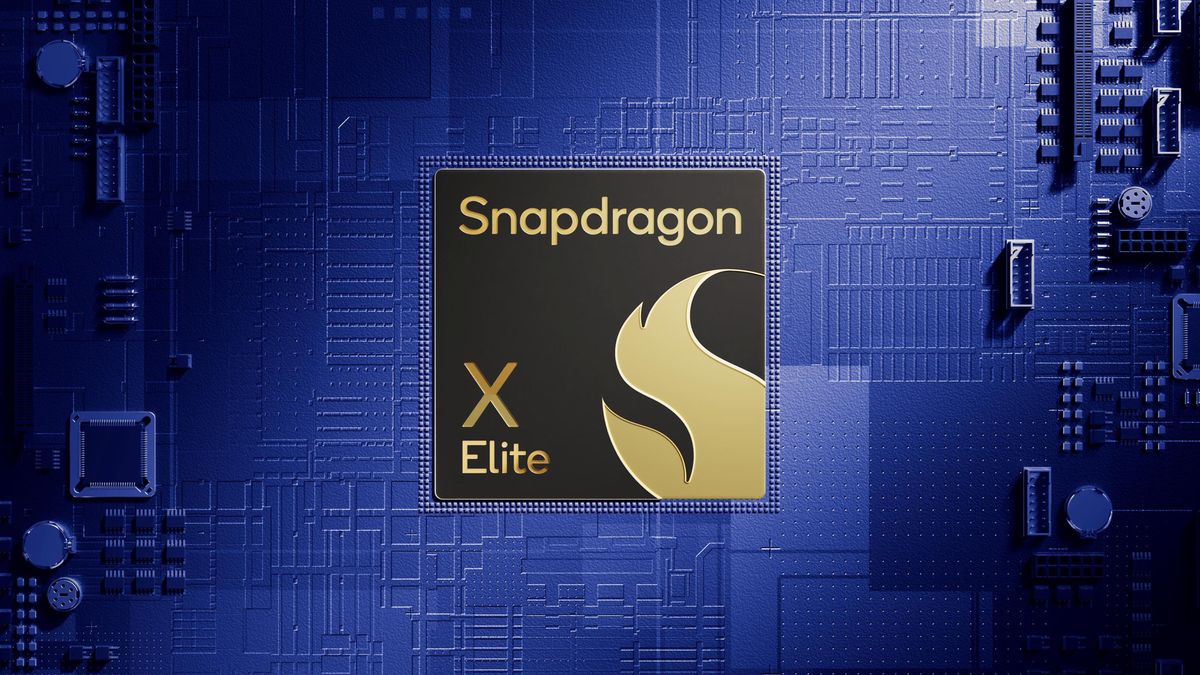




:quality(85):upscale()/2024/10/22/748/n/49351773/91b7c9cd6717d96c4691b3.90797788_.png)

 English (US) ·
English (US) ·